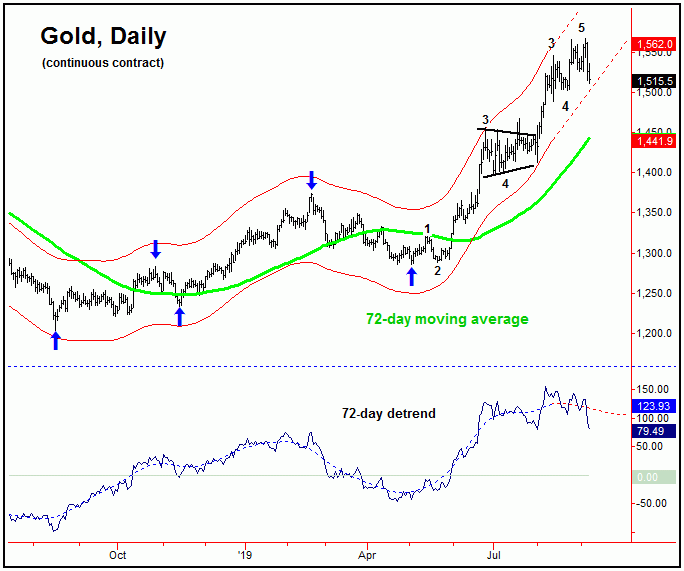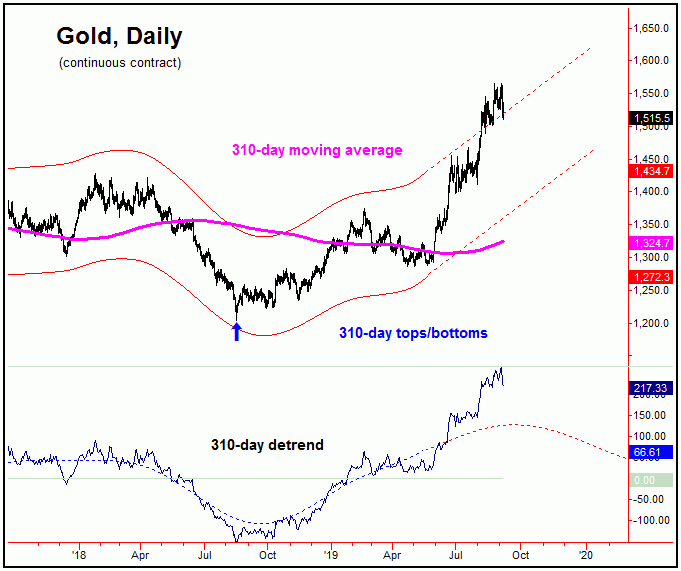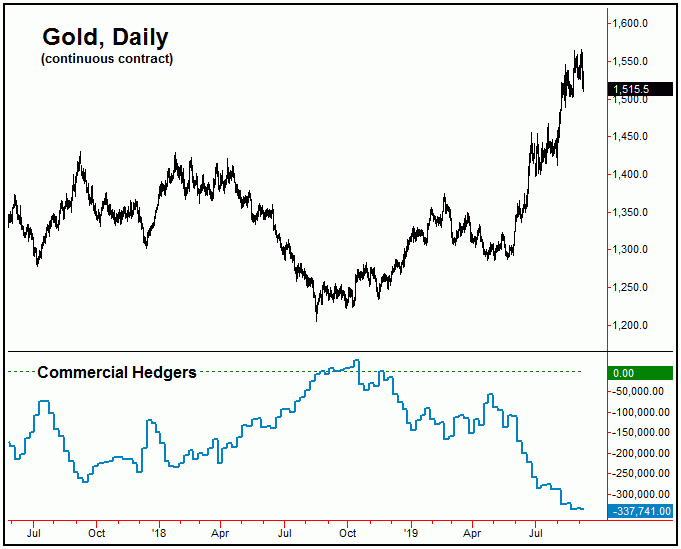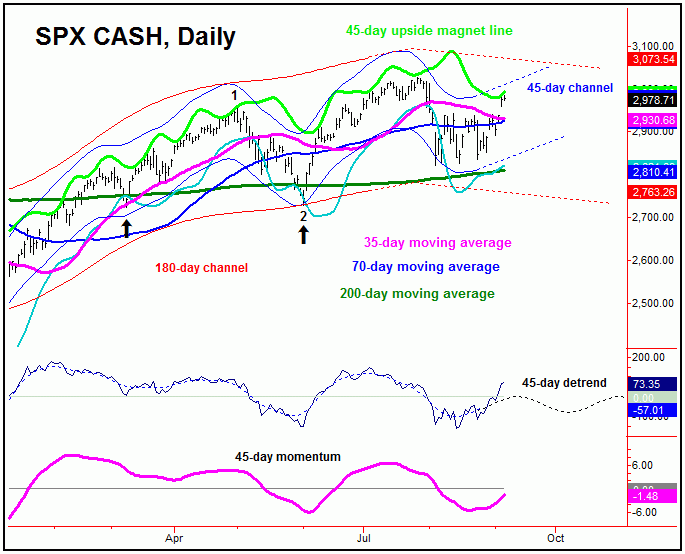Gold Forecast: Gold Price Confirms Reversal - Down Cycle In Play

Last week's trading witnessed the gold market once again forming the more bearish pattern of an early-week high into resistance, with the index hitting a peak of 1566.20, made on a Wednesday time top. From there, a sharp reversal to the downside was seen, one that saw the metal dropping all the way down to a Friday low of 1510.70 - before bouncing off the same into the daily/weekly close.
Gold Cycles Reverse
From the comments made in recent weeks, the gold cycles were seen as moving into the range for a top - and with that a correction phase of the entire rally up from the early-May trough was expected to be the next move of significance. We sent out an email alert early in Thursday's session, which confirmed a reversal south with the 72-day time cycle that we track, which we now see as heading to the downside in the coming weeks.
Gold's 72-day Cycle
As noted last weekend, even with the gold cycles in topping range, no peak of importance was confirmed to be in place - with the metal needing a reversal below the 1490's to confirm the same. Having said that, these numbers are always moving up with price, and with that we were able to confirm the reversal south at much higher price levels, in Thursday's session.
With the above said and noted, here again is our 72-day time cycle:
On the chart above, there is a fairly clear Elliott five waves up into the 1566 swing top (December, 2019 contract), and with that a three-wave, or ABC correction, is now favored to be in force. Inside that three waves, we are likely in the first wave down, which - once complete - should give way to a decent countertrend rally, before turning down to lower lows in wave 'C' of the move.
In terms of price, since the greater-majority (i.e., 85% or better) of the downward phases of this 72-day cycle will see a drop back to the 72-day moving average or lower, the ideal path favors an ABC correction back to this figure. Doing so would also represent a 38-50% retracement off the highs, which is a normal-enough affair, following the completion of five waves up. Even said, there is always the potential for a larger decline than forecast.
In terms of time, we have a key date where the next trough for this 72-day wave is likely to materialize, with the precise details noted in our thrice-weekly Gold Wave Trader market report.
In terms of patterns, due to the configuration of the larger-degree cycles that we track, the probabilities favor the correction phase of the 72-day component to end up as an eventual countertrend affair - holding well above the early-May price trough. If correct, a push back to higher highs should materialize into later this year - before forming a much larger-degree peak.
Take a look at the chart below:
The above chart shows one of the largest cycles that we track, which is the 310-day component. In eyeballing this chart, we can see that it is pointing higher into later this year, where it should then top out for a much larger percentage decline into the Spring of 2020 (or later). In terms of price, if and when this wave does top out, a correction back to the 310-day moving average should be expected, a moving average which is obviously well below current price levels.
For now, however, the path for the coming weeks/months favors a correction with the 72-day wave, higher highs on the next upward phase of that cycle, then to be on the lookout for technical indications of a much more important high forming.
Gold Commercial Hedgers
In looking at sentiment indications this weekend, the commercial hedgers for the gold market added approximately 4,000 new short bets, which brings their current net short (bearish) total up to some 337,741 contracts - with the data current to the 9/3/19 close. Here is our chart:
From the comments made in recent articles, the positioning of the commercial hedgers was viewed as our best indication - and supporting evidence - for a correction phase. As mentioned, this correction should come from the 72-day cycle, which is confirmed to be pointing south at the present time.
Once again, the commercials are holding their largest net short position seen since just before the July, 2016 top - which was a major peak for the gold market; it was also a high for our 310-day time cycle.
With the above said and noted, I have mentioned at least the potential for a stronger decline than anticipated - simply due to the action of the hedgers, as well as another sentiment indicator that we track (but not shown here, due to time constraints). However, the cycles suggest only a countertrend decline for now, followed by a higher high - where I would expect the hedgers to be holding an even larger net bearish total.
For the bigger picture, the hedgers appear to be positioning for an eventual larger decline phase, which, as noted earlier, should come from our 310-day time cycle.
U.S. Stock Market
With the action seen in past weeks, the SPX was in the midst of a correction phase with the 45 and 90-day cycles that we track - a move which was anticipated to end up as countertrend. The reversal higher seen last week, we see these waves as having bottomed - and thus have turned back to the upside. Here is the smaller 45-day cycle, shown again on the chart below:
Going further with the above, the ideal path favors a push back to or above the all-time highs in the coming weeks, then to set up for a potential 'mini' crash wave into the month of October, which is when our seasonal cycle is projected to trough.
Stepping back, as mentioned many times in prior articles, we see the bull market in stocks continuing well into the Spring of 2020 or later. With that, smaller-degree corrections of 5-7% are seen as normal affairs, and which should look to be bought - as we were able to do during the most recent decline.
For the much bigger picture, the yield-curve inversion is a negative fundamental indication for stocks - and suggests the possibility of an economic recession in the next few years. Recessionary periods in the business cycle are normally accompanied by the downward phase of the largest cycle that we track - the four-year component. The average declines with the stock market - inside this downward phase - has been approximately 34% from peak-to-trough.
With the above then said and noted, the technical indications that we track will become paramount in the coming months - though for now each of these are still in decent shape, though we expect this to eventually change at some point going forward.
Jim Curry
The Gold Wave Trader
http://goldwavetrader.com/
http://cyclewave.homestead.com/
********




















